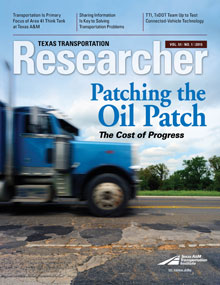
Agency Director
Texas is a resource-rich state. Blessed with oil and natural gas reserves, Texas has been a principal supplier of natural resources for the nation for more than a century. Although resource development is always welcome — and a boon to the state’s economy — planning for it can be challenging.
New discoveries of oil and gas reserves drive how and where they’re developed, as we saw recently with the Eagle Ford Shale formation in South Texas. Two-lane rural roads designed for farmers and ranchers driving pickup trucks proved inadequate for 18-wheelers hauling heavy loads. Roads began to fail faster and require maintenance more often than originally scheduled. Other aspects of the transportation network — like regional airports, railroads and ports in Texas — are impacted as well.
Although the energy boom in Texas has slowed recently due to falling oil prices abroad, there’s no doubt that once prices stabilize again, the same issues — which become safety issues when infrastructure fails — will once again challenge the Lone Star State. Now is a good time to apply lessons learned by Texas A&M Transportation Institute (TTI) researchers about how to mitigate the impacts of energy development on the Texas transportation system.

This issue of the Texas Transportation Researcher looks at a number of these challenges. The use of new innovative maintenance techniques, like using foamed asphalt, can make road repairs faster and less costly. We’ve partnered with the Texas Department of Transportation (TxDOT) to produce technical briefs that educate district engineers about procedures that can help them maintain local infrastructure while minimizing costs.
When 90 percent of the freight on the Texas portion of the Gulf Intracoastal Waterway is petroleum and chemical related, properly maintaining our state’s maritime system significantly impacts the economy, and TTI researchers have made recommendations to TxDOT for how to improve maintenance. A study by our Transportation Policy Research Center looked at eight other states dealing with these issues. In a separate transportation pooled-fund project led by TxDOT, TTI researchers will help states share experiences and conduct additional research. And by evaluating the impact of energy development on pavement over time, we can help TxDOT refine its planning process as it prioritizes future projects.
Through research, we’re learning how to better cope with the impact of the energy sector on our infrastructure when booms occur while aiding Texas in achieving the economic benefits that come with natural resource development. Properly timing the implementation of research findings is a critical aspect to achieving a good return on the investment of research dollars. While resource development might be at a momentary lull in Texas, the state has an opportunity to help better coordinate the transportation network and the private sector to redress existing maintenance and safety problems and work toward troubleshooting similar issues in the future. To that end, TTI is working with TxDOT and our other partners by producing quality research that leads to practical, implementable solutions for Texans — solutions sometimes necessary even at the best of times.
